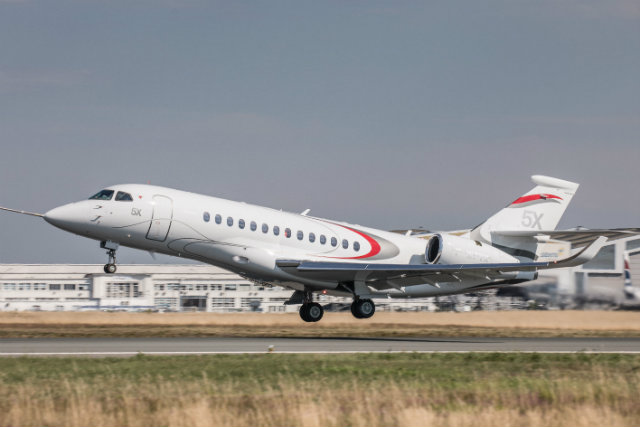Faced with yet another delay to the development schedule for its Falcon 5X business jet, Dassault made a bold move in December to axe the ultra-wide-cabin aircraft and end its increasingly fractured relationship with Safran, whose troubled Silvercrest engine programme has been major source of frustration for the French airframer.
The 5X will now be replaced in Dassault's four-strong line-up of high-end, twin- and tri-engined aircraft by a new Falcon. Scheduled to enter service in 2022, the yet-to-be-named model will be powered by a variant of the Pratt & Whitney Canada PW800 series. The powerplant specialist's PW300-family engines already power three members of the Falcon range: the 7X, 8X and 2000LXS.
Aerospace analyst Brian Foley believes Dassault took a “calculated risk” in selecting Safran – a newcomer to the business aviation market – as the propulsion supplier for the 5X, a risk which has proved costly and exasperating.
Delivery of the first 11,450lb-thrust (51kN) Silvercrest was originally pegged for the end of 2013, to comply with the 5X's flight-test schedule.

Dassault Aviation
However, recurrent technical issues with the turbofan's development forced Dassault to delay entry-into-service of the clean-sheet twin from its target date of 2017 to 2020. Using preliminary versions of the engine, the 5X made its first flight in July 2017, but Dassault’s hopes were dashed again in early October, when Safran announced that it had encountered new problems with the turbofan’s high-pressure compressor during ground and flight tests, further delaying 5X certification.
This was the final straw for Dassault, which has suffered significant order cancellations for the 5X due to the “slippage” – including 12 in 2016 alone.
The frustration boiled over on 14 December, with the airframer declaring: “Considering the magnitude of the risks involved both on the technical and schedule aspects of the Silvercrest programme, Dassault Aviation initiates the termination process of the Silvercrest contract leading to the end of the 5X, and plans to start negotiations with Safran.”
Dassault had been counting on the 5X to jump-start sales of its Falcon jets, which have been in decline since 2014, thanks largely to the downturn in its traditional marketplaces such as Asia and the Middle East and a bloated inventory of pre-owned large-cabin jets.
Speaking at its first-half results presentation on 26 July – the last time the company provided a market update – Dassault Aviation chairman Eric Trappier said reviving Falcon sales was the company’s “number one priority”, as another dismal six months for orders saw the backlog of super-midsize 2000LXS, large-cabin 900LX, long-range 7X and flagship ultra-long-range 8X fall to about 60, representing about 15 months of production at current rates.
Aerospace analyst Rolland Vincent says: “Backlog has been declining, and book-to-bill has been below one over the past three years despite management’s prudent decisions to slow down the rates of new aircraft production. The last solid year for Falcon sales was in 2014, when 90 net new orders were booked.”

Safran
While it awaits a much-needed recovery, Dassault will be hoping the new Falcon will reaffirm its commitment to enhancing its business jet product line. Despite the 5X’s demise, Trappier says: “There is still a strong market need for a brand-new, long-range aircraft with a very large cabin.” This latest Falcon will feature the same cross-section as the 5X, he adds, and a range of 5,500nm (10,180km) – 300nm more than that of the 5X – which should appeal to customers looking for longer-range missions including US west coast to Europe and North Africa and Europe to southern Africa.
The 5,500nm range and 2.58m (102in)-wide cabin pitches the new Falcon against established brands including the Bombardier Global 5000 and 6000 as well as Gulfstream’s clean-sheet G500 and G600. The Gulfstream pair – which are also powered by variants of the PW800 series – are slated for service entry in the first quarter and fourth quarter of 2018, respectively.
The 5X’s original development timetable would have placed its entry into service slightly ahead of the G500, and a year before the G600. However, with first deliveries not expected until 2022, the new Falcon will be playing catch-up with its rivals.
Foley believes that while the Silvercrest troubles have been tough for Dassault, the fallout is unlikely to cause the airframer any lasting damage. “The market understands why the 5X was delayed and eventually cancelled, and will likely give Dassault a pass," he says.
For Vincent, the new Falcon is an opportunity for the company to “close a sad chapter in its log book and move on to a new nomenclature", citing the 6X as a possible choice. It can “refresh its messages”, he adds, “and come to the market with an even better design that takes advantage of the last several years of technological advancements to bring additional features on board”.

Textron Aviation
What does the future hold for the Silvercrest? While its remaining customer, Textron Aviation, says it is committed to the engine for its Hemisphere large-cabin business jet – scheduled to begin flight testing in 2019 – Vincent believes its destiny depends on how quickly Safran can correct the current issues, and reassure the airframer that all is well.
“Textron Aviation, which appears to be at a fairly early stage in the engineering development of the Hemisphere, will presumably be welcoming many a team from Safran [to its Wichita, Kansas headquarters] in the weeks and months to follow, seeking to reassure the OEM that matters are under control,” he says. “Other engine companies will be like hawks circling Wichita for the opportunity to displace Safran at Textron Aviation.”
Source: Flight International


























